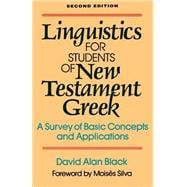
| Foreword | p. ix |
| Preface to the Second Edition | p. xi |
| Preface | p. xiii |
| Acknowledgments | p. xvii |
| Introducing Linguistics: The Landscape and the Quest | p. 1 |
| Why Study Linguistics? | p. 1 |
| What Is a Linguist? | p. 4 |
| What Is Linguistics? | p. 5 |
| How Do Linguists Go About Their Work? | p. 5 |
| How Does Linguistics Differ from Traditional Grammar? | p. 12 |
| How Do Linguists Characterize Language? | p. 15 |
| How Is Linguistics Related to Other Fields? | p. 18 |
| Suggestions for Further Reading | p. 22 |
| Phonology: The Sounds of Greek | p. 23 |
| Language as Sound | p. 23 |
| The Speech Process | p. 24 |
| Phonetics: How Sounds Are Made | p. 25 |
| Phonemics: Sounds as System | p. 40 |
| Common Phonological Processes in Greek | p. 42 |
| Why Study Phonology? | p. 51 |
| Suggestions for Further Reading | p. 52 |
| Morphology: The Anatomy of Greek Words | p. 53 |
| The Concept of the Morpheme | p. 53 |
| The Greek Morphological System | p. 58 |
| Why Study Morphology? | p. 91 |
| Suggestions for Further Reading | p. 94 |
| Syntax: The Architecture of the Greek Sentence | p. 96 |
| Structure and Content Words | p. 97 |
| Immediate Constituent Analysis | p. 100 |
| Greek Sentence Patterns | p. 102 |
| Expanding the Greek Sentence | p. 106 |
| Transformations | p. 114 |
| Suggestions for Further Reading | p. 118 |
| Semantics: Determining Meaning | p. 120 |
| Etymology | p. 121 |
| Word and Concept | p. 123 |
| General and Secondary Meanings | p. 124 |
| Synonyms, Hyponyms, and Opposites | p. 125 |
| Semantic Classes | p. 128 |
| Ambiguity | p. 129 |
| Denotation and Connotation | p. 130 |
| Idioms | p. 131 |
| Rhetorical Language | p. 132 |
| Semantic Change | p. 136 |
| Analyzing Discourse | p. 138 |
| Suggestions for Further Reading | p. 141 |
| Historical and Comparative Linguistics: The Biography of Greek | p. 143 |
| The Indo-European Family of Languages | p. 144 |
| The Story of Greek | p. 149 |
| Major Characteristics of Koine Greek | p. 156 |
| English and Greek | p. 162 |
| Suggestions for Further Reading | p. 168 |
| Discourse Analysis: Getting the Big Picture | p. 170 |
| Exemplar: The Discourse Structure of Philippians | p. 172 |
| The Primary Text-Sequences of Philippians | p. 173 |
| The Primary Sub-Sequences of Philippians | p. 176 |
| Summary: The Discourse Structure of Philippians | p. 191 |
| Conclusion | p. 196 |
| Suggestions for Further Reading | p. 197 |
| Postscript | p. 199 |
| Subject Index | p. 203 |
| Scripture Index | p. 213 |
| Table of Contents provided by Syndetics. All Rights Reserved. |
The New copy of this book will include any supplemental materials advertised. Please check the title of the book to determine if it should include any access cards, study guides, lab manuals, CDs, etc.
The Used, Rental and eBook copies of this book are not guaranteed to include any supplemental materials. Typically, only the book itself is included. This is true even if the title states it includes any access cards, study guides, lab manuals, CDs, etc.